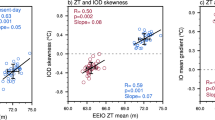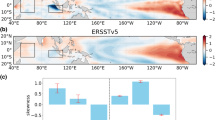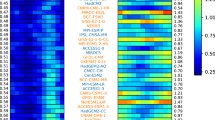Abstract
The impact of marine ecosystem on the tropical climate variability in the Indian Ocean is investigated by performing coupled ocean/biogeochemical model experiments, which are forced by realistic surface winds from 1951 to 2010. Results from a suite of chlorophyll perturbation experiments reveal that the presence of chlorophyll can have significant effects on the characteristics of the Indian Ocean Dipole (IOD), including its amplitude and skewness, as well as on the mean state. Specifically, chlorophyll increases mean sea surface temperature due to direct biological heating in regions where the mean mixed layer depth is generally shallow. It is also found that the presence of chlorophyll affects the IOD magnitude by two different processes: One is the amplifying effect by the mean chlorophyll, which leads to shoaling of mean thermocline depth, and the other is the damping effect by the interactively varying chlorophyll coupled with the physical model. There is also a biological impact on the skewness of the IOD, resulting in enhanced positive skewness. This skewness change is primarily caused by the phase dependency of the above two contradicting effects involving the asymmetric thermocline feedback and the nonlinear mixed layer heating.










Similar content being viewed by others
References
AchutaRao K, Sperber KR (2006) ENSO simulation in coupled ocean-atmosphere models: are the current models better? Clim Dyn 27(1):1–15
An S-I, Jin F–F (2001) Collective role of thermocline and zonal advective feedbacks in the ENSO mode. J Clim 14:3421–3432
An SI, Jin FF (2004) Nonlinearity and asymmetry of ENSO. J Clim 17(12):2399–2412
An SI, Kug JS, Ham YG, Kang IS (2008) Successive modulation of ENSO to the future greenhouse warming. J Clim 21(1):3–21
Anderson G (1969) Subsurface chlorophyll maximum in the northeast Pacific Ocean. Limnol Oceanogr 14(3):386–391
Anderson W, Gnanadesikan A, Wittenberg A (2009) Regional impacts of ocean color on tropical Pacific variability. Ocean Sci 5(3):313–327
Arrigo KR, Robinson DH, Worthen DL, Dunbar RB, DiTullio GR, VanWoert M, Lizotte MP (1999) Phytoplankton community structure and the drawdown of nutrients and CO2 in the Southern Ocean. Science 283(5400):365–367
Ashok K, Guan ZY, Yamagata T (2003) Influence of the Indian Ocean Dipole on the Australian winter rainfall. Geophys Res Lett 30(15):1821
Behrenfeld MJ et al (2001) Biospheric primary production during an ENSO transition. Science 291(5513):2594–2597
Bjerknes J (1969) Atmospheric teleconnections from the equatorial pacific. Mon Weather Rev 97(3):163–172
Cai WJ, van Rensch P, Cowan T, Hendon HH (2012) An Asymmetry in the IOD and ENSO Teleconnection Pathway and Its Impact on Australian Climate. J Clim 25(18):6318–6329
Campbell JW (1995) The lognormal distribution as a model for bio-optical variability in the sea. J Geophys Res 100(C7):13237–13254
Dunne JP, Murray JW, Aufdenkampe AK, Blain S, Rodier M (1999) Silicon-nitrogen coupling in the equatorial Pacific upwelling zone. Global Biogeochem Cycles 13(3):715–726
Dunne JP, Armstrong RA, Gnanadesikan A, Sarmiento JL (2005) Empirical and mechanistic models for the particle export ratio. Global Biogeochem Cycles 19(4):GB4026
Esaias WE et al (1998) An overview of MODIS capabilities for ocean science observations. IEEE Trans Geosci Remote Sens 36(4):1250–1265
Field CB, Behrenfeld MJ, Randerson JT, Falkowski P (1998) Primary production of the biosphere: integrating terrestrial and oceanic components. Science 281(5374):237–240
Franz BA, Werdell PJ, Meister G, Bailey SW, Eplee RE, Feldman GC, Kwiatkowskaa E, McClain CR, Patt FS, Thomas D (2005) The continuity of ocean color measurements from SeaWiFS to MODIS. Paper presented at proceedings of SPIE
Geider RJ, MacIntyre HL, Kana TM (1996) A dynamic model of photoadaptation in phytoplankton. Limnol Oceanogr 41(1):1–15
Ginoux P, Chin M, Tegen I, Prospero JM, Holben B, Dubovik O, Lin SJ (2001) Sources and distributions of dust aerosols simulated with the GOCART model. J Geophys Res 106(D17):20255–20273
Gnanadesikan A, Dunne JP, John J (2011) What ocean biogeochemical models can tell us about bottom-up control of ecosystem variability. ICES J Mar Sci 68(6):1030–1044
Griffies SM, Schmidt M, Herzfeld M (2009) Elements of mom4p1. GFDL Ocean Group Tech Rep 6:444
Guilyardi E, Braconnot P, Jin FF, Kim ST, Kolasinski M, Li T, Musat I (2009) Atmosphere feedbacks during ENSO in a coupled GCM with a modified atmospheric convection scheme. J Clim 22(21):5698–5718
Hastenrath S, Nicklis A, Greischar L (1993) Atmospheric-hydrospheric mechanisms of climate anomalies in the western equatorial Indian Ocean. J Geophys Res 98(C11):20219–20235
Henson SA, Dunne JP, Sarmiento JL (2009) Decadal variability in North Atlantic phytoplankton blooms. J Geophys Res 114:C04013
Hong CC, Li T, Ho L, Kug JS (2008) Asymmetry of the Indian Ocean dipole. Part I: observational analysis. J Clim 21(18):4834–4848
Hong CC, Li T, Ho L, Chen YC (2010) Asymmetry of the Indian Ocean Basinwide SST anomalies: roles of ENSO and IOD. J Clim 23(13):3563–3576
Jochum M, Yeager S, Lindsay K, Moore K, Murtugudde R (2010) Quantification of the feedback between phytoplankton and ENSO in the community climate system model. J Clim 23(11):2916–2925
Kahru M, Gille ST, Murtugudde R, Strutton PG, Manzano-Sarabia M, Wang H, Mitchell BG (2010) Global correlations between winds and ocean chlorophyll. J Geophys Res 115:C12040
Kalnay E et al (1996) The NCEP/NCAR 40-year reanalysis project. Bull Am Meteorol Soc 77(3):437–471
Kang IS, Kug JS, An SI, Jin FF (2004) A near-annual Pacific Ocean basin mode. J Clim 17(12):2478–2488
Large W, Yeager S (2004) Diurnal to decadal global forcing for ocean and sea-ice models: the data sets and flux climatologies. Tech Note TN-460+STR. Natl Cent Atmos Res, Boulder, Colo
Lengaigne M, Menkes C, Aumont O, Gorgues T, Bopp L, Andre JM, Madec G (2007) Influence of the oceanic biology on the tropical Pacific climate in a coupled general circulation model. Clim Dyn 28(5):503–516
Levy M, Shankar D, Andre JM, Shenoi SSC, Durand F, Boyer de Montegut C (2007) Basin-wide seasonal evolution of the Indian Ocean’s phytoplankton blooms. J Geophys Res 112(C12):C12014
Li CY, Mu MQ (2001) The influence of the Indian Ocean dipole on atmospheric circulation and climate. Adv Atmosp Sci 18(5):831–843
Loptien U, Eden C, Timmermann A, Dietze H (2009) Effects of biologically induced differential heating in an eddy-permitting coupled ocean-ecosystem model. J Geophys Res 114:C06011
Lynch DR, Gentleman WC, McGillicuddy DJ, Davis CS (1998) Biological/physical simulations of Calanus finmarchicus population dynamics in the Gulf of Maine. Mar Ecol Prog Ser 169:189–210
Manizza M, Le Quéré C, Watson AJ, Buitenhuis ET (2005) Bio-optical feedbacks among phytoplankton, upper ocean physics and sea-ice in a global model. Geophys Res Lett 32:L05603
Marzeion B, Timmermann A, Murtugudde R, Jin FF (2005) Biophysical feedbacks in the tropical Pacific. J Clim 18(1):58–70
McClain CR, Cleave ML, Feldman GC, Gregg WW, Hooker SB, Kuring N (1998) Science quality SeaWiFS data for global biosphere research. Sea Technol 39(9):10–16
Morel A (1988) Optical modeling of the Upper Ocean in relation to its biogenous matter content (Case I Waters). J Geophys Res 93(C9):10749–10768
Morel A, Berthon JF (1989) Surface pigments, algal biomass profiles, and potential production of the euphotic layer: relationships reinvestigated in view of remote-sensing applications. Limnol Oceanogr 34(8):1545–1562
Murray RJ (1996) Explicit generation of orthogonal grids for ocean models. J Comput Phys 126(2):251–273
Murtugudde R, McCreary JP, Busalacchi AJ (2000) Oceanic processes associated with anomalous events in the Indian Ocean with relevance to 1997–1998. J Geophys Res 105(C2):3295–3306
Murtugudde R, Beauchamp J, McClain CR, Lewis M, Busalacchi AJ (2002) Effects of penetrative radiation on the upper tropical ocean circulation. J Clim 15(5):470–486
Nakamoto S, Kumar SP, Oberhuber JM, Muneyama K, Frouin R (2000) Chlorophyll modulation of sea surface temperature in the Arabian Sea in a mixed-layer isopycnal general circulation model. Geophys Res Lett 27(6):747–750
Ohlmann JC (2003) Ocean radiant heating in climate models. J Clim 16(9):1337–1351
Park JY, Kug JS, Park YG (2012) A modeling study on bio-physical processes associated with ENSO. Submitted to Progress in Oceanography
Paulson CA, Simpson JJ (1977) Irradiance measurements in the upper ocean. J Phys Oceanogr 7(6):952–956
Resplandy L, Vialard J, Levy M, Aumont O, Dandonneau Y (2009) Seasonal and intraseasonal biogeochemical variability in the thermocline ridge of the southern tropical Indian Ocean. J Geophys Res 114:C07024
Saji NH, Yamagata T (2003) Possible impacts of Indian Ocean Dipole mode events on global climate. Clim Res 25(2):151–169
Saji NH, Goswami BN, Vinayachandran PN, Yamagata T (1999) A dipole mode in the tropical Indian Ocean. Nature 401(6751):360–363
Sathyendranath S, Gouveia AD, Shetye SR, Ravindran P, Platt T (1991) Biological control of surface temperature in the Arabian Sea. Nature 349(6304):54–56
Smith TM, Reynolds RW, Peterson TC, Lawrimore J (2008) Improvements to NOAA’s historical merged land-ocean surface temperature analysis (1880–2006). J Clim 21(10):2283–2296
Sweeney C, Gnanadesikan A, Griffies SM, Harrison MJ, Rosati AJ, Samuels BL (2005) Impacts of shortwave penetration depth on large-scale ocean circulation and heat transport. J Phys Ocean 35(6):1103–1119
Timmermann A, Jin FF (2002) Phytoplankton influences on tropical climate. Geophys Res Lett 29(23):2104
Turner AG, Joshi M, Robertson ES, Woolnough SJ (2011) The effect of Arabian Sea optical properties on SST biases and the South Asian summer monsoon in a coupled GCM. Clim Dyn 39:1–16
Wang L, Chen W, Huang RH (2007) Changes in the variability of North Pacific Oscillation around 1975/1976 and its relationship with East Asian winter climate. J Geophys Res 112(D11):D11110
Webster PJ, Moore AM, Loschnigg JP, Leben RR (1999) Coupled ocean-atmosphere dynamics in the Indian Ocean during 1997–98. Nature 401(6751):356–360
Wetzel P, Maier-Reimer E, Botzet M, Jungclaus J, Keenlyside N, Latif M (2006) Effects of ocean biology on the penetrative radiation in a coupled climate model. J Clim 19(16):3973–3987
Wiggert JD, Murtugudde RG, McClain CR (2002) Processes controlling interannual variations in wintertime (Northeast Monsoon) primary productivity in the central Arabian Sea. Deep-Sea Res. Part II 49(12):2319–2343
Yamagata T, Behera SK, Luo JJ, Masson S, Jury MR, Rao SA (2004) Coupled ocean-atmosphere variability in the tropical Indian Ocean. Earth Clim Ocean Atmosp Interact Geophys Monogr 147:189–211
Yu LS, Rienecker MM (1999) Mechanisms for the Indian Ocean warming during the 1997–98 El Nino. Geophys Res Lett 26(6):735–738
Acknowledgment
This work was supported by the National Research Foundation of Korea (Grant NRF-2009-C1AAA001-2009-0093042) funded by the Korean government (MEST).
Author information
Authors and Affiliations
Corresponding author
Rights and permissions
About this article
Cite this article
Park, JY., Kug, JS. Marine biological feedback associated with Indian Ocean Dipole in a coupled ocean/biogeochemical model. Clim Dyn 42, 329–343 (2014). https://doi.org/10.1007/s00382-012-1640-5
Received:
Accepted:
Published:
Issue Date:
DOI: https://doi.org/10.1007/s00382-012-1640-5




